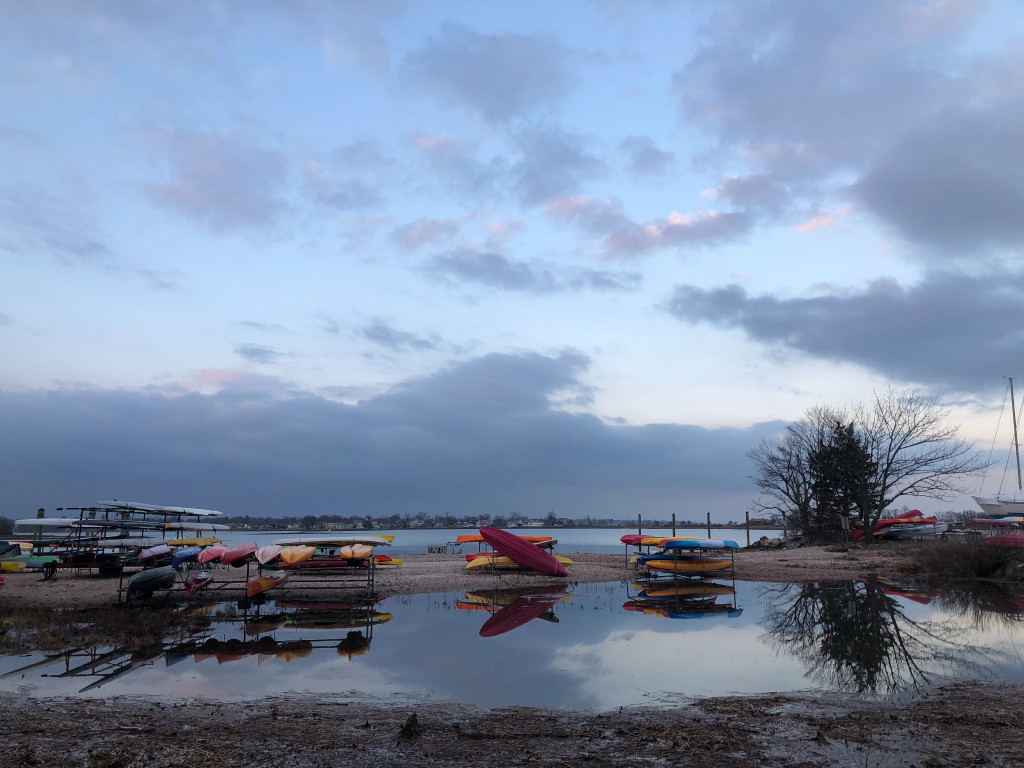
A view of the Long Island Sound from my backyard. (Jane Cameron/George Washington University)

A view of the Long Island Sound from my backyard. (Jane Cameron/George Washington University)
I watched the flames dance and sway in the wind, crackling across the line of houses less than two miles from my home. On the other side of my house, the seawall was enveloped by the ocean and water was encroaching, about to reach our back door. Hurricane Sandy caused the sky to darken, lit up only by lightning and slowly ravaging our town and everything in its path.
Many of my friends’ homes were lost, flooded or incinerated by fire when the transformer blew up as the angry waves smacked against it. Our town had no power for weeks, trees had turned the roads into an obstacle course, and we were forced to remain in place. The devastation of Hurricane Sandy that struck our town and swept across the East Coast was foreign to my adolescent mind. Since then, every time a hurricane or tropical storm passes over Connecticut, I hold my breath and hope there will not be a repeat of that destruction. Unfortunately, climate change is forming the perfect recipe for more aggressive and frequent hurricanes.

Sea levels rising and ocean waters increasing in temperature will fuel hurricanes to extremes, making storms like Sandy a common occurrence in the Northeast. The National Climate Assessment projects that hurricanes in the Atlantic Ocean will more commonly be Category 4 and 5, the strongest and most deadly type of hurricanes. What’s more, evidence from the Physics Organization shows that hurricanes in the Northeast will linger longer, not retreating and bringing more severe damage to towns.
Current Connecticut environmental regulations are not sufficient to impede the frightening changes that face us. However, organizations like 350CT and Save the Sound have produced actionable plans to combat these significant events. They have proposed legislative actions focused on areas such as electricity, transportation, and buildings, which would allow the state to reduce CO2 emissions and lessen the growing climate threat. While increased regulations have been enacted in the last year, the state is still not investing enough to contribute to national CO2 emission reductions and is primarily focused on infrastructure projects to protect land from the storms.

As tropical storms, ones less severe than Sandy, have passed through Connecticut since 2012, the water levels have been alarming. The Environmental Defense Fund reported that the average global sea level has increased by half a foot since 1900. This suggests that storm surges during hurricanes, when waters rise above normal levels and are pushed inland by wind, will occur more frequently. The sea level around Bridgeport, a town in Connecticut, has already increased by five inches since 1964 and continues to rise even faster than before, reports SeaLevelRise.org.
Bridgeport, the largest city in my district, is also the most densely populated, with the greatest diversity of ethnic backgrounds in Connecticut. Unfortunately, the Department of Housing and Urban Development reports that if measures are not taken this city will flood regularly by 2100. Critical infrastructure, such as train lines, hospitals, sewage plants and airports are greatly threatened, and many residents feel that the only thing they can do is hope these buildings can face the fury of the storm. This community is still recovering with help from the state after Ida, a hurricane that hit over a year ago. With low income families concentrated in this area, the state will need to come to their aid again and again, but if the entire Connecticut population is soon in turmoil from recurring hurricanes, resources will start to spread thin.
With 61% of the state’s population located in coastal communities prone to flooding, vulnerability to hurricanes is widespread and only increasing. The Connecticut Department of Energy and Environmental Protection projects that by 2080 the state may lose 24,000 acres of land from sea level rise. Consequently, people will be left to move inland or live in high-risk homes that may be treacherous during a hurricane.
When I think of how my mom lives on her own next to the ocean, I feel a sudden uneasiness. With the growing threat of storms, she must choose between moving out of our family home or feeling endangered every time a hurricane warning is issued.

The National Climate Assessment has detailed that 32% of northern and Mid-Atlantic beaches will over-wash due to intense Nor-Easter type storms. The risk of towns transforming into wreckage will only increase if global warming continues at this pace since this number rises to over 80% if the hurricane is Category 4 or higher, the type of hurricane that increases in correlation with global warming. While the state implements protection from the imminent storms, reversing climate change should be the real goal, so we are not continuously living in fear. We should be working toward solutions to global warming rather than just spending on infrastructure to reduce devastating damage.